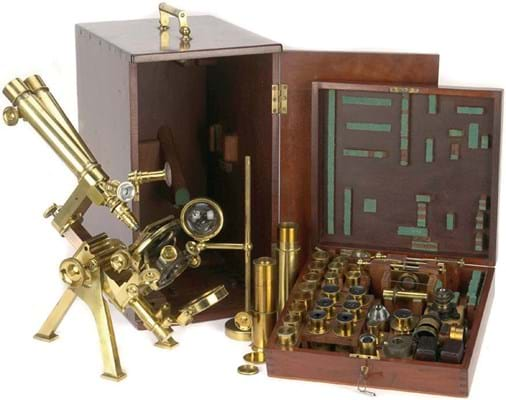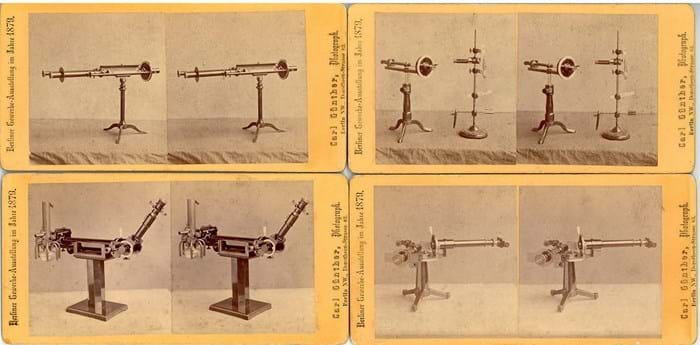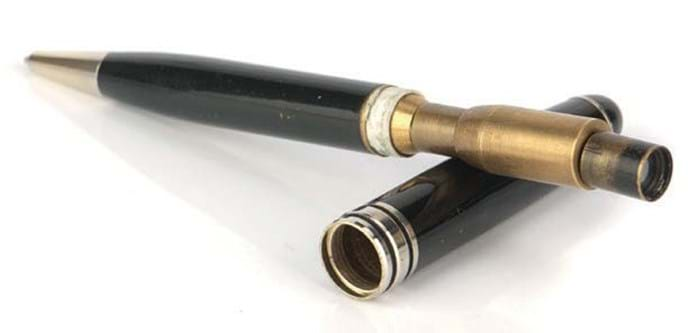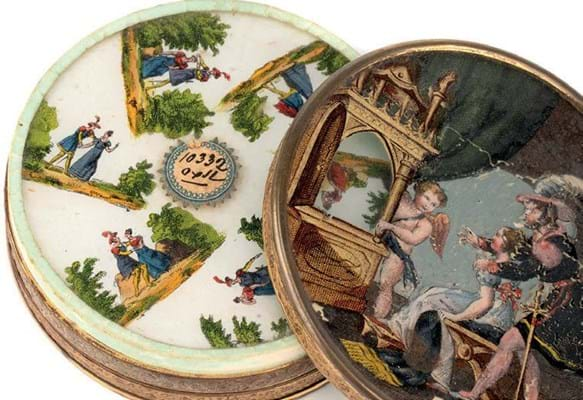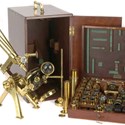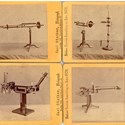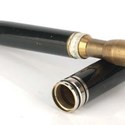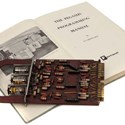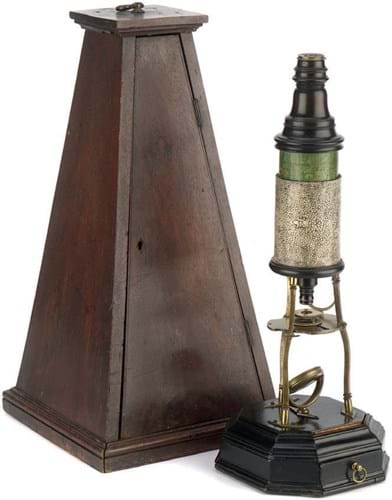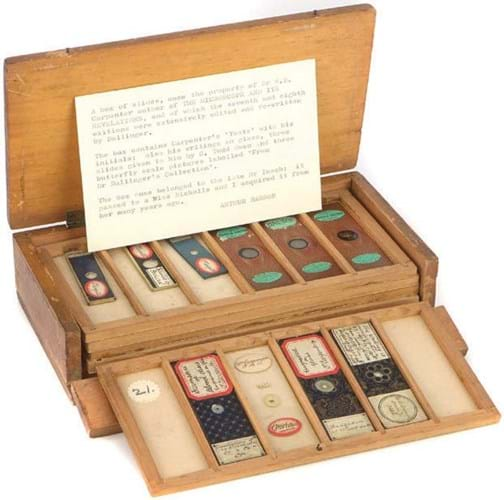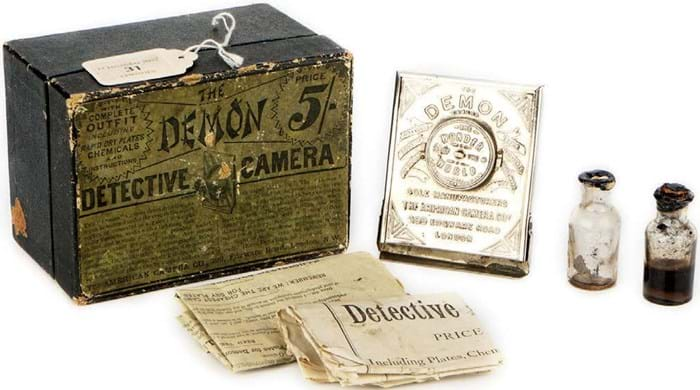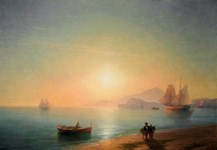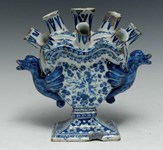In his 1892 book The Microscope its Construction and Management, the Belgian Henri Van Heurck (1839- 1909) wrote glowingly of a firm based on Euston Road in London.
“Messrs Powell & Lealand occupy quite a unique position in the microscopic world. Their workshops are small, the number of instruments which they produce are few, but every piece of apparatus, marked with their name, is an artistic production, perfect in all its details.
“Both instruments and objectives of these makers are in the greatest request and are used in England by all serious microscopists.”
Hugh Powell and brother-in-law Peter Lealand, partners from 1841, gave model numbers to four of their microscope designs.
The famous No 1, first issued in 1869 and made for close to 40 years, was the most celebrated instrument of the ‘brass and glass’ era, with its massive stand and huge range of accessories. No 2 was similar in size but came with fewer gadgets. No 3 was smaller and No 4 designed as a portable ‘in the field’ model with features for compact packing.
Dedicated auction
Very good examples of both the No 1 and the No 2 appeared for sale as part of the Fine Photographica and Instruments of Science auction at specialist Flints (plus 25% buyer’s premium) on May 21.
The version of No 1 was dated 1875 and carried a presentation inscription for the Irish civil engineer Bindon Blood Stoney (1828–1909) from the Institution of Civil Engineers. The previous year the ICE had awarded Stoney the Telford Medal for a paper on his work on the Dublin harbour northern quays.
This was no mean gift. According to Powell & Lealand’s 1875 catalogue, a No 1 with a full complement of accessories would have cost £264 7s (more than £20,000 today). It tipped estimate to bring £26,000.
It was more than another No 1 dated 1897 that sold for £24,000 at Bonhams Knightsbridge in 2017 but not quite in the league of the super-equipped example dated 1871 sold by Flints for a record £32,000 last October.
The No 2 microscope was dated 1869 and came with a good complement of accessories. A handwritten note detailing much of the contents carried the name SA Humphrey of 21 Paradise Street, Birmingham – an optician recorded as supplying vulcanite cells to many microscope slide preparers. It was sold towards the lower end of expectations at £8200.
Of the earlier microscopes in the sale – those from the age of Enlightenment rather than the age of Exploration – the best was a Culpepper-type monocular microscope c.1740.
Made in finely turned lignum vitae, brass, shagreen and vellum with a black lacquered octagonal box foot, these are commonly attributed to Matthew Loft (1697-1747) whose paper label and Royal Exchange address at ‘the sign of the Golden Spectacles’ appears to the drawer on several examples.
However, it is now thought he and others were retailers of a product made in parts across numerous London workshops. Offered in an associated oak case, it sold within estimate for £9000 on thesaleroom.com.
Slide effects
Microscope slides were a strong feature of this sale and the subject of some lively bidding contests.
Estimated at up to £2000 but sold at £17,000 was a six-tray box of exhibition slides with a handwritten label connecting its contents with the English physician, zoologist and physiologist William Benjamin Carpenter (1813-85) and William Henry Dallinger (1842-1909), a Wesleyan minister and biologist.
Carpenter was the author of The Microscope and its Revelations, a popular hobby treatise published from 1856, with Dallinger the editor of the much-revised seventh and eighth editions. The box contains a number of Carpenter’s ‘tests’ carrying his initials plus examples of his miniature writings on glass.
‘From Dr Dallinger’s collection’ were three ‘micromosaic’ pictorials by Harold Dalton (1829-1911). Using a boar bristle and up to 1000 single scales of exotic butterfly specimens, Dalton created these pictures – in this case a chicken and chicks, a large vase of flowers, and including an image of a bird in flight, a fern and a snail.
Kenyte from Nimrod
Also bringing way more than suggested was a single slide containing a piece of the glassy mineral kenyte labelled Shackleton Antarctic Expdtn. It was estimated at just £40-60 but sold at £3800 via thesaleroom.com.
Kenyte is found on Mount Erebus, Antarctica’s second-highest volcano, that was scaled for the first time during the British Antarctic or Nimrod Expedition of 1907-09. A much larger piece collected at Cape Barne, Ross Island, was presented by Sir Ernest Shackleton himself to the University of Sydney in 1909.
Spy cameras and an extraordinary stereoscope featured in the Fine Photographica tranche of the sale.
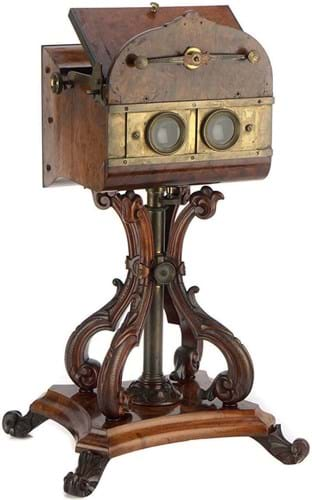
Natural Stereoscope by Wood of Huddersfield with a burr walnut and lacquered brass stand – £18,000 at Flints.
The Natural Stereoscope was patented in 1862 by John Hirst and Joseph Wood of Huddersfield in the hope ‘to neutralise the granular, fibrous, and general coarseness of objects seen through stereoscopic glasses’. By using a series of coloured filters the image could be changed ‘from cold to warm or from sun to moonlight’.
This (unsigned) decoratively carved version with a burr walnut stand is described by Paul Wing in Stereoscopes: The First 100 Years as the deluxe model, of which fewer than 20 are known. Christie’s South Kensington sold one for £10,000 in 2002. This example took £18,000.
The chrome-plated Demon Detective Camera, the only camera made by the England-based American Camera Company, was priced at a budget 5s when first released in 1885.
An advert of the time boasted ‘No movement is too rapid for it – the racehorse at greatest speed, the flight of birds, even the lightning flash itself’. It was also claimed 100,000 cameras had been made but today that is deemed a gross overstatement.
The example here, complete with chemical bottles, plates and instructions, in maker’s box was one of the most complete examples offered since this one was sold in 2002 at Christie’s for £1800. The hammer price this time was £1700.
CP Stirn’s waistcoat camera, made in Germany from 1886-88, was one of perhaps 15,000 made.
Also ex-Christie’s, the example here was an uncommon export version for the French market and came in its original box titled L’Invisible. It took £1300: an uplift on the price in 2004 of £1000.


